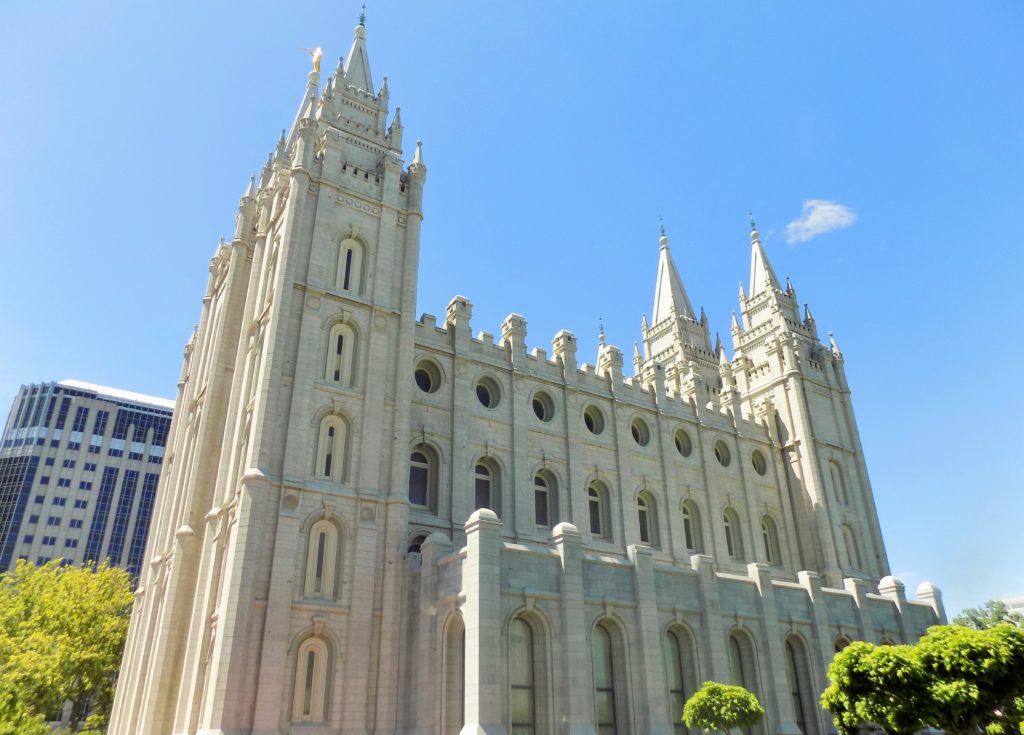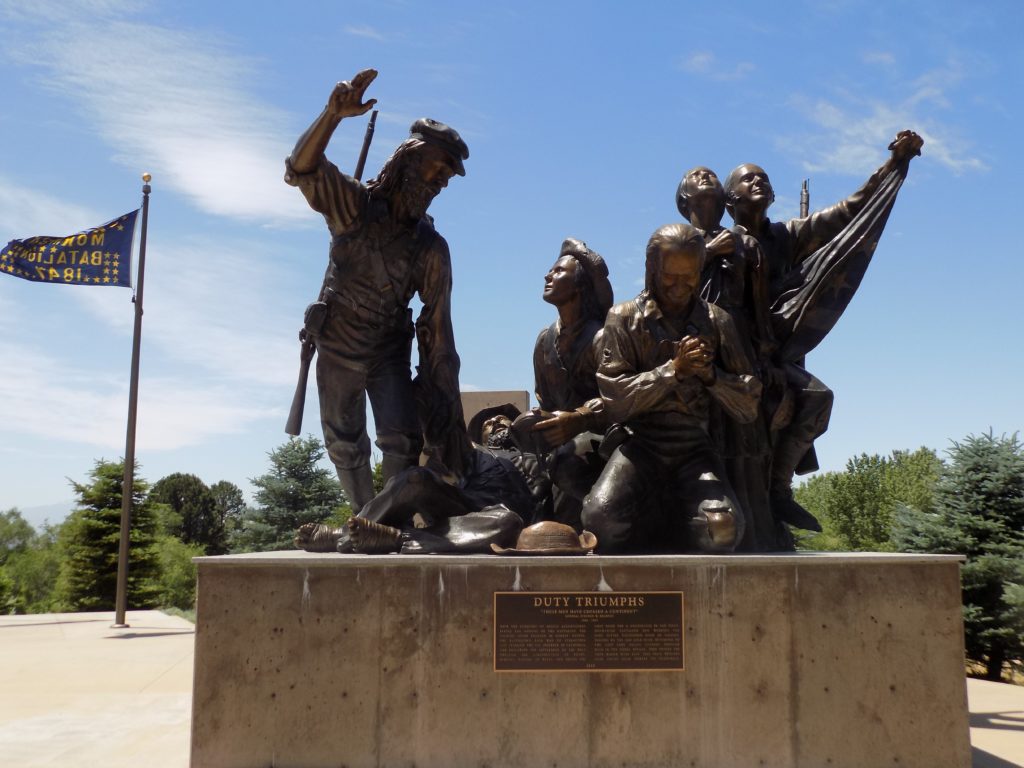After visiting the Pioneer Memorial Museum the day was still young and I had plans aplenty. I walked down the hill from the Capitol to circumvent Temple Square and look at the main Temple of the Church of Jesus Christ of the Latter-Day Saints (LDS) because, well, that’s de rigueur in Salt Lake City. Here it is:
This might not be the best or most imposing angle but I’m not one to stand at the front and take the typical picture.
If you’re hoping for more about the Temple itself, you’re on your own. There’s a visitor’s center and I believe visitors can enter the Tabernacle which was completed in 1867 under Brigham Young’s supervision and leadership. I visited neither.
I’ll stress that if these sorts of religiously themed activities interest you, Temple Square and the surrounding area is rife with places you’d find interesting. There’s the Temple itself, the Church History Museum, the Family History and Church Libraries, and more. As for me, I was off to the This Is The Place Monument.
Galloping into legend
This Is The Place Historical Monument mainly marks one of the signal events in the history of the LDS church by celebrating the place where Brigham Young is supposed to have uttered his famous statement prompting the settlement of the Great Salt Lake Valley.
The monument is just one part of the This is the Place Heritage Park that’s also a commercial enterprise that combines a history park and its “Heritage Village” – a place I didn’t need to visit since I’d been to the real thing in Nauvoo – with an amusement park. The public space has three prominent monuments plus a fourth less prominent but equally important memorial that requires a bit of a search to find.
The first monument I encountered was an unexpected memorial to the Pony Express. Most Americans reading this are probably familiar with the legend of the Pony Express. In some ways, just as Monument Valley implanted itself in the American consciousness as the landscape of the west, the Pony Express also became symbolic of 19th century westward expansion mainly because of its use as a recurring motif in dime novels, western films, and melding with frontier lore.
Even Americans, however, might not know that the Pony Express officially operated for only 18 months between April 1860 and October 1861 or that its actual operation was suspended in May and June of 1860 when the battles at Pyramid Lake were fought between the U.S. Army and local Paiute Indians. This interruption in service immediately created significant financial stress for the fledgling business which was officially called the Central Overland California & Pike’s Peak Express Company.
At a time when regular mail delivery typically required 25 days to cross the 2,000-mile route between St. Joseph, Missouri and Sacramento, California, the need for a service like the Pony Express became almost essential in the late 1840’s when the westward expansion of European and Anglo-Americans accelerated. The exodus of the Mormons from Nauvoo was one driving factor as was the discovery of gold at Sutter’s Mill in California.
Horse and rider relay teams shuttled mail carried in specially designed saddles along the route with its riders switching mounts every 10-15 miles and, after covering 75-100 miles, handing their cargo to a new courier. The process was so efficient and the riders so daring that the Pony Express usually covered the full distance in less than half the time of its competitors – usually needing just 10 days to travel from Missouri to California.
But not only can speed kill, it can cost, too. The riders were limited to weighing no more than 125 pounds and were very well paid – earning fixed salaries of between $100 and $150 per month. The cost of supplies, the horse changing stations and maintaining the number of horses needed (a typical trip could require more than 100 horses) made the service exceptionally expensive. Each half-ounce piece of mail a rider carried cost the sender five dollars. That would be a lot of money today. It was really a lot of money in 1860.
A mere 10 weeks after the service began operating, the U.S. Congress authorized a bill to subsidize a transcontinental telegraph line connecting the Missouri River with the Pacific Coast – an act that would soon drive a stake through the heart of the Pony Express.
Though it continued losing money, the Pony Express operated as usual while the telegraph lines were under construction. Once the line was complete, however, the bell tolled for the Pony Express. Still, it galloped into legend.
Marching beyond Deseret – the Mormon Battalion
When the charismatic Mormon leader Joseph Smith purchased the town of Commerce, Illinois and renamed it Nauvoo, he hoped that the followers of his LDS Church would find it a haven from the persecution and religious conflicts that had dogged the believers wherever they’d settled. It didn’t. Harassment, both legal and violent, continued.
Smith, who was far from a non-controversial figure particularly because of his belief in the practice of polygamy, was murdered (some say assassinated) in 1844. After fighting off the claims of other potential successors, Brigham Young emerged as the principal leader of the Church. Even after Smith’s death, anti-Mormon violence persisted and the Mormons knew little peace.
Early in 1846, Young concluded that the Mormons had to abandon Nauvoo and seek a new sanctuary. He organized the exodus that would eventually lead them to the Great Salt Lake Basin. On 10 February 1846, Young began leading 1,600 of the 12,000 Nauvoo Mormons to a winter camp at Sugar Grove, Iowa. As the spring approached, Young sent an emissary to Washington to ask the federal government for some sort of protection on their march.
That emissary, Jesse Little, landed in Washington a mere eight days after Congress had declared war on Mexico. Local contacts helped him meet with high officials and Little then offered a battalion of Mormon men to serve in the war. On 2 June 1846, President James K. Polk accepted the offer on the condition that at least several hundred men would enlist. Thus was created the only religiously based unit in United States military history – the Mormon Battalion.
More than 500 men enlisted under the command of the Lieutenant Colonel Stephen Kearny who ordered them to march from near Council Bluffs, Iowa to San Diego, California under the leadership of Captain Philip St. George Cooke. One of their main tasks was building a wagon road along the 2,000-mile trek. Although they played a role in the “Capture of Tucson” – a narrative I’ll detail on my return to that city – their march was uneventful excepting one rather singular incident near the San Pedro River in Arizona.
Having set out in July, they reached this part of Arizona in November 1846 where they encountered a herd of untended wild cattle. Their presence apparently disturbed the bulls who charged the camp destroying some of the mules and wagons and wounding two men. The soldiers responded as soldiers will. They loaded their guns and killed between 10 and 15 of the offending beasts in a skirmish that sarcastically came to be called “The Battle of the Bulls.”
The Mormon Battalion reached San Diego on 29 January 1847 where they remained for the next five months until their discharge on 16 July. By this time, both Kearny (Brigadier General) and Cooke (Lt. Colonel) had received promotions. While there, the battalion also performed duties in several locations in southern California including serving as peacekeepers in a dispute between the Californios and Luiseños tribes.
Some confusion arose between John C. Freemont and Kearny regarding the governance of the territory. Thus, it’s likely the most significant service the battalion provided in California was serving as a reliable unit under Cooke that General Kearny could count on in his conflict with Fremont over who was the rightful Governor of California.
Young, who during his lifetime proved himself not only an effective and savvy leader but who was also an exceptional businessman, made shrewd political and financial use of the battalion. Based on their past experience some, of Young’s counselors were suspicious of possible government betrayal. Young, however, viewed the enlistment as a potential public relations victory for the Church because it would provide concrete evidence of its loyalty to the United States.
Financially, while Little had been unable to secure direct financial aid from the federal government, the men who enlisted were given an annual uniform allowance of $42 each that was paid in advance when they reached Fort Leavenworth, Kansas. However, because they would be allowed to wear their civilian clothing for the march, they immediately donated the bulk of the money they received to a general Church fund which Young then used to purchase wagons, teams, and other necessities for the LDS American exodus.


